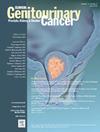Modifiable Cardiovascular Risk Factors Amongst Men With and Without Prostate Cancer in a Large, Prospective Registry
IF 2.7
3区 医学
Q3 ONCOLOGY
引用次数: 0
Abstract
Introduction
Noncancer mortality, namely cardiovascular, is the leading cause of death in men with prostate cancer. We examined modifiable risk factors for cardiovascular disease in men with and without prostate cancer.
Patients and Methods
We used data from the UK Biobank, a large, prospective registry, to identify 186 830 men recruited between 2006 and 2010 without missing clinical covariate data. We performed age-matched comparisons (1:5) between men with (N = 2 720) and without (N = 13 600) prostate cancer to assess for differences in modifiable cardiovascular risk factors (smoking status, lipid profile, hypertension, etc.). This analysis was repeated after stratifying for men with (N = 4 302) and without dyslipidemia (N = 12 018).
Results
In the overall cohort, men with prostate cancer were significantly less likely to be smokers or have diabetes than age-matched men without prostate cancer but were more likely to have higher total (P = .006) and low-density lipoprotein (LDL)-cholesterol (P = .006) levels. Cholesterol-lowering medication use did not differ between groups (P = .479). In the subgroup with dyslipidemia, men with prostate cancer had significantly higher total cholesterol levels (P = .004) without differences in cholesterol medication use (P = .722). In the cohort without dyslipidemia, men with prostate cancer trended toward lower active smoking (P = .052) and higher blood pressure medication use (P = .052) but had no difference in total cholesterol levels (P = .266).
Conclusion
In this analysis, we show that men with prostate cancer may have a higher total and LDL-cholesterol levels. However, cholesterol-lowering medication use may be underutilized in this population. As cardiovascular mortality is a leading cause of death in this population, integrated oncologic, cardiovascular, and primary care is paramount. Further work refining personalized, longitudinal risk factor modification is important for optimizing life expectancy in this population.
在一项大型前瞻性登记研究中,男性前列腺癌患者和非前列腺癌患者可改变的心血管危险因素
非癌症死亡,即心血管死亡,是前列腺癌患者死亡的主要原因。我们检查了患有和不患有前列腺癌的男性心血管疾病的可改变危险因素。患者和方法我们使用了来自英国生物银行(UK Biobank)的数据,这是一个大型的前瞻性登记,在2006年至2010年期间招募了18830名男性,没有缺少临床协变量数据。我们在前列腺癌患者(N = 2720)和非前列腺癌患者(N = 13600)之间进行年龄匹配(1:5)比较,以评估可改变的心血管危险因素(吸烟状况、血脂、高血压等)的差异。对有(N = 4 302)和无血脂异常(N = 12 018)的男性进行分层后重复该分析。结果在整个队列中,前列腺癌患者吸烟或患糖尿病的可能性明显低于年龄匹配的无前列腺癌男性,但更有可能具有较高的总(P = 0.006)和低密度脂蛋白(LDL)-胆固醇(P = 0.006)水平。两组之间降胆固醇药物的使用没有差异(P = .479)。在血脂异常亚组中,前列腺癌患者的总胆固醇水平明显较高(P = 0.004),而胆固醇药物的使用差异无统计学意义(P = 0.722)。在没有血脂异常的队列中,前列腺癌患者倾向于减少主动吸烟(P = 0.052)和使用高血压药物(P = 0.052),但总胆固醇水平没有差异(P = 0.266)。结论:在这项分析中,我们发现前列腺癌患者可能有更高的总胆固醇和低密度脂蛋白胆固醇水平。然而,在这一人群中,降胆固醇药物的使用可能没有得到充分利用。由于心血管死亡是这一人群的主要死亡原因,因此肿瘤学、心血管和初级保健的综合治疗至关重要。进一步完善个性化、纵向风险因素修正的工作对于优化这一人群的预期寿命非常重要。
本文章由计算机程序翻译,如有差异,请以英文原文为准。
求助全文
约1分钟内获得全文
求助全文
来源期刊

Clinical genitourinary cancer
医学-泌尿学与肾脏学
CiteScore
5.20
自引率
6.20%
发文量
201
审稿时长
54 days
期刊介绍:
Clinical Genitourinary Cancer is a peer-reviewed journal that publishes original articles describing various aspects of clinical and translational research in genitourinary cancers. Clinical Genitourinary Cancer is devoted to articles on detection, diagnosis, prevention, and treatment of genitourinary cancers. The main emphasis is on recent scientific developments in all areas related to genitourinary malignancies. Specific areas of interest include clinical research and mechanistic approaches; drug sensitivity and resistance; gene and antisense therapy; pathology, markers, and prognostic indicators; chemoprevention strategies; multimodality therapy; and integration of various approaches.
 求助内容:
求助内容: 应助结果提醒方式:
应助结果提醒方式:


